Track-based Alignment for the Belle Vertex Detector Using the Millepede
Approach
Martin Ritter
Diploma Thesis
supervised by Prof. Christian Kiesling
Ludwig-Maximilians-Universit¨ at – Department of Physics Max-Planck-Institut f¨ ur Physik
September 30th, 2009
ii
iii
Abstract
Why do we exist? CP-Violation is an integral part of this question as its understanding is crucial to explain the matter-antimatter asymmetry observed in our universe. Several experiments were designed and carried out to precisely measureCP-Violation, especially in the B-meson system where large asymmetries where predicted and found.
With Belle II and LHCb, two new experiments are going to improve the existing measurements. Belle II will be based on the very successful and still running Belle experiment at the KEKB collider, currently holding the world record on luminosity with 2.11×1034cm−2s−1. These asymmetric e+e−-collision experiments impose challenging demands on the detectors due to the needed precision, high trigger rates and hostile radiation environment.
Silicon technology based vertex detectors are needed to be able to resolve the decay vertices of the B-mesons with the required precision below 100µm. The performance of these vertexing detectors is dominated by the ability to determine the correct position of the silicon sensors. Only a track-based, time-dependent alignment is able to achieve the required precision. As a preparation for Belle II, a new alignment strategy for the Belle experiment has been implemented, using the χ2 minimization package Millipede II where all correlations between the position parameters are taken into account.
In this thesis, the principles of the CP-Violation measurements and track-based alignment will be presented. An initial implementation showing the feasibility of the new alignment strategy is shown and evaluated using Monte Carlo data.
iv
v
Zusammenfassung
Warum existieren wir? CP-Verletzung ist ein integraler Bestandteil dieser Frage, da ihr Verst¨andnis notwendig ist, um die in unserem Universum beobachtete Asymmetrie zwischen Materie und Antimaterie zu erkl¨aren. Dementsprechend wurden bereits mehrere Experimente zur Vermessung der CP-Verletzung geplant und auch durchgef¨uhrt. Dies geschah vor allem mit B-Mesonen, bei welchen großeCP-Asymmetrien vorausgesagt und dann auch best¨atigt wurden.
Mit Belle II und LHCb werden bald zwei neue Experimente diese Messungen verbessern.
Belle II basiert auf dem Design des erfolgreichen und noch im Betrieb befindlichen Belle Ex- perimentes am KEKB Beschleuniger, welcher mit einer Luminosit¨at von 2.11×1034cm−2s−1 momentan den Weltrekord h¨alt. Durch die ben¨otigte Pr¨azision, die hohen Triggerraten sowie die hohe Strahlungsbelastung stellen diese asymmetrischen e+e− Kollisionsexperi- mente besonders hohe Anspr¨uche an die Detektoren.
Halbleiterbasierte Vertexdetektoren sind notwendig um die Zerfallspositionen der B-Mesonen mit der erforderlichen Genauigkeit von unter 100µm zu bestimmen. Die Leistungf¨ahigkeit dieser Vertexdetektoren wird davon bestimmt, wie gut die exakte Position der Siliziumsensoren ermittelt werden kann. Die hierbei erforderliche Pr¨azision kann nur mit einer spurbasierten, zeitabh¨angigen Detektorausrichtung erreicht werden.
Als Vorbereitung auf Belle II wurde eine neue Ausrichtungsstrategie entwickelt, die sich des χ2-Minimierungspaketes Millepede II bedient. Dies erm¨oglicht es, alle Korrelationen zwischen den Positionsparametern verschiedener Module zu ber¨ucksichtigen.
Die vorliegenden Arbeit bietet eine Einf¨uhrung in die Grundlagen der Messung von CP-Verletzungen und der Detektorausrichtung. Eine erste Implementierung der neuen Ausrichtungsstrategie wurde durchgef¨uhrt und die Details, sowie eine Evaluierung mittels Monte Carlo Daten, werden p¨asentiert.
vi
Contents
1 Introduction 1
2 Physics motivation 5
2.1 C, P and T-Symmetry . . . . 5
2.2 Flavour Physics . . . . 6
2.3 Neutral Meson Mixing . . . . 8
2.4 CP-Violation . . . 10
2.4.1 Unitarity Triangle . . . 13
2.4.2 Time Dependent CP-Violation . . . 14
2.4.3 Measurement of CP-Violation . . . 18
3 The Belle Experiment 21 3.1 KEKB Accelerator . . . 21
3.2 Belle Detector . . . 23
3.2.1 Beampipe . . . 23
3.2.2 Silicon Vertex Detector . . . 24
3.2.3 Central Drift Chamber . . . 25
3.2.4 Aerogel Cherenkov Counter . . . 27
3.2.5 Time of Flight Counter . . . 28 vii
viii Contents
3.2.6 Electromagnetic Calorimeter . . . 28
3.2.7 Solenoid . . . 29
3.2.8 K0L/µDetector . . . 30
3.3 SuperKEKB/Belle II . . . 30
4 Track-based Detector Alignment 35 4.1 Introduction . . . 35
4.2 Alignment Requirements . . . 36
4.3 Coordinate Conventions . . . 37
4.4 Track Parametrization . . . 39
4.5 Generic Approach . . . 40
4.6 Local Alignment . . . 41
4.7 Alignment Using a Kalman Filter Technique . . . 42
4.8 Global Alignment Using the Millepede-Approach . . . 42
4.8.1 Matrix Reduction . . . 43
4.8.2 Linear Equation Solvers . . . 45
4.8.3 Constraints . . . 46
4.8.4 Outlier Rejection/Down-weighting . . . 47
5 Implementation of the Alignment Procedure 49 5.1 Current Alignment in Belle . . . 49
5.2 Belle Analysis Framework (BASF) . . . 50
5.3 Generated Monte Carlo Data . . . 51
5.3.1 Muon Pairs from e+e−→µ−µ+ . . . 52
5.3.2 Cosmic Muons . . . 53
5.3.3 Reconstruction of Tracks . . . 54
Contents ix
5.4 New Alignment Approach . . . 55
5.4.1 Selection of Tracks . . . 57
5.4.2 Calculation of Residuals . . . 58
5.4.3 Constraining of the Global SVD Position . . . 64
5.5 Weak defined Modes . . . 66
6 First Results of Internal SVD Alignment 71 6.1 Estimation of the SVD Performance after Alignment . . . 79
6.1.1 Impact Parameters . . . 79
6.1.2 Helix Parameter Correlation . . . 80
7 Conclusions and Outlook 83
A Helix parameter correlations 85
List of Figures 91
List of Tables 95
Bibliography 97
Acknowledgements 105
Eigenst¨andigkeitserkl¨arung 107
x
Chapter 1 Introduction
Over the last 30 years, particle physics has been a very vivid and successful area of research, revealing many fundamental and interesting aspects of our universe. Yet many unresolved mysteries remain.
Cosmology and field theory predicts that the universe was created in the Big Bang, with extremely high temperatures, way beyond the energy scales achievable by present- day accelerators. This initial ultra-high energy density inevitably gives rise to the creation of particle-antiparticle pairs which leads to two possible scenarios: either the particle-antiparticle pairs could annihilate, ultimately leaving a sea of photons in which we could not exist or there should be equal amounts of matter and antimatter, somehow separated to prevent annihilation. Yet, although the observed photon to proton ratio is about 10−9, no evidence for significant amounts of antimatter could be established over cosmological distances. Thus, the excess of matter over antimatter has to be explained by an asymmetry between the way matter and antimatter react. In 1976, Sakharov formulated a mechanism to generate this cosmological matter asymmetry based on three conditions [1]
• Non-conservation of baryonic charge
• Deviation from the thermal equilibrium
• Breaking of the matter-antimatter symmetry (breaking of theCandCPsymmetry) The Standard Model (SM) of particle physics describes the known elementary particles and their interactions very successfully and has been verified with high precision [2]. It
1
2 Introduction
contains 3 generations of fermions: quarks and leptons which are the fundamental matter particles and possess spin 12. These particles exchange field quanta which mediate the forces between them and are called gauge bosons with spin 1. They follow from local gauge invariance according to the symmetry group of the SM, SUC(3)×SUL(2)×UY(1) Although the SM has been verified to a high degree of precision there are still some tensions and aspects which are not completely satisfactory, including the large number of parameters which can only be deduced by experiments, like for example the flavour mixing, or the fact that the SM does not describe Dark Matter or Dark Energy and thus only accounts for approx. 4−5% of the known universe [3, 4].
CP-Violation was discovered in 1964 in the Kaon system and could be integrated into the SM in 1972 by Kobajashi and Maskawa using only one CP-violating phase, the KM phase. Since this formalism is only possible for three quark generations, they predicted 3 quarks in addition to the 3 quarks known at that time. Then in 1980, based on the observation of a surprisingly long lifetime of the B mesons, Bigi, Carter and Sanda pointed out that the B0B0-system may show large time-dependent CP-Asymmetries.
Two dedicated experiments where commissioned to explore these asymmetries: BaBar in the USA and Belle in Japan. And indeed, a large CP-Violation in the B-meson sector was observed by 2001 in B0 →J/ψK0S decays [5, 6].
The KM model describes CP-Violation by introducing an irreducible complex phase to the weak flavour mixing. However, it can be shown that the amount of CP-Violation in the SM cannot cover the observed matter-antimatter asymmetry and new sources of CP-Violation are needed besides the single KM phase now present in the SM. These sources could enter the observed CP-Asymmetries via loop diagrams. This makes CP-Violation sensitive to detect new physics in a range from 600 GeV to more than
∼500 TeV, depending on the amount of flavour violation of these new physics[7]. But to challenge the SM, high precision measurements with very high statistics are needed, like the upcoming upgrade for Belle or complementary experiments like LHCb.
With current technology it is not possible to directly measure the short B-meson lifetime of τB = 1.5 ps, which is needed to measure CP-Violation. But it is possible to transform this lifetime into a measurable distance ∆z between the decay vertices of the two B mesons by boosting the system. Even so, very high precision vertexing detectors are needed. The only technology available today which can resolve vertices with the needed precision better than 100µm are silicon based detectors. These detectors consist of many planar wafers which are organized around the interaction region, usually in a
Introduction 3
layered structure. The Belle experiment utilizes a 4 layer double sided strip detector consisting of 246 separate modules. The intrinsic point resolution of these modules is about 15µm inrφ-direction and 22µm in z-direction. To profit from this resolution, the position of every silicon module has to be known very precisely. Studies by the Belle Collaboration have determined that the crucial ∆z resolution of the two B-mesons will deteriorate by more than 5%, if the maximum uncertainty of the module position is 20µm for translations and 0.2 mrad for rotations [8]. Since the assembly precision is in the order of 100µm, additional measures have to be taken to achieve the required position.
Survey information can be used to measure the assembly position more precisely, yet only relative position measurements between single detector modules are possible.
Furthermore, such surveys are not able to determine changes in the detector geometry after the assembly, for example as a result of the high magnetic field used for momentum measurement. Since the relative movement of silicon modules attached to larger structures is not expected to change significantly after alignment, surveys can be very useful to reduce uncertainties of such structues.
Laser systems can be used to continuously monitor relative changes between the detector components during operation. Due to the limited space it is not possible to install the required hardware to measure the position of every single module. Yet bigger substructures can be monitored very precisely and continuously during operation.
The most precise and most common method used to align detectors is track-based alignment. This method uses tracks which traverse the detector to calculate alignment corrections for each detector module that can then be used in reconstruction to correct the position of the sensors.
In the following chapter, the principles of CP-Violation measurements will be pre- sented and the need for the required precision will be motivated. An overview of the Belle experiment shall be given together with a brief outlook for the upcoming Belle II in chapter 3. In chapter 4 we will present the principles and of track-based detector alignment, focussing on global alignment with the Millepede method. The details of the implemented approach inside the Belle Analysis Framework (BASF) will be discussed in chapter 5. Finally, first results of this new approach using Monte Carlo studies will be presented in chapter 6.
4
Chapter 2
Physics motivation
In this chapter, the basic principles of CP-Violation measurements are developed. Start- ing with a short introduction about basic symmetry operations, the time evolution of neutral mesons is discussed. The principles ofCP-Violation will be presented and the observables will be defined. A brief outline of the experimental techniques utilized to be able to measure these observables is given.
2.1 C, P and T-Symmetry
Symmetries are very important in physics since every operation which leaves a system invariant corresponds to a conservation law according to Noether’s theorem [9]. For example, rotational symmetry corresponds to the conservation of angular momentum and invariance under translations in space or time corresponds to the conservation laws of momentum and energy respectively. Important discrete symmetries in the Standard Model (SM) are the Charge C, Parity P and Time Conjugation T
Charge conjugation transforms a particle q into its antiparticle ¯q by leaving mass, momentum and spin invariant, but inverting the quantum numbers like flavour and electric charge
C|qi=|¯qi (2.1)
Parity transformations are discrete operations which mirror the physical system in space, thus the coordinate x, momentum p and angular momentum l ≡ x×p
5
6 Physics motivation
transform as follows:
x−→ −P x p−→ −P p l−→P l (2.2)
It can be seen that we can distinguish between two types of vectors: Polar vectors V that change their sign and axial vectors A which are invariant under parity transformation. This also leads to the distinction of scalarsS= V·V =A·A−→P S and pseudoscalars P =V ·A−→ −P P.
Time conjugation reflects t into −t while leaving x unchanged, thus representing a reversal of motion
x−→T x p−→ −T p l−→ −T l (2.3)
Until the 1950s, P- and C-conservation were believed to be fundamental conservation laws like the conservations of energy and momentum. Trying to explain theθ−τ puzzle in 1956, Tsung-Dao Lee and Chen Ning Yang pointed out that, while verified in strong and electromagnetic interactions, parity conservation was hitherto untested in weak decays [10]. They proposed several direct experimental tests and in the same year, Chien-Shiung Wu et al. demonstrated [11] that parity conjugation is violated maximally in weak decays, i.e. the weak interaction only couples to left-handed neutrinos.
Soon after, Landau pointed out that the combined transformationCPis still conserved [12]. This seemed to be very important since it can be shown quite generally that violation of CPT would also lead to a violation of Lorentz invariance. To be precise, the CPT- theorem states that any Lorentz invariant local quantum field theory with a Hermitian Hamiltonian must have CPT symmetry [13]. Thus if CP is violated, alsoT needs to be broken to conserve CPT.
2.2 Flavour Physics
The SM describes the interaction of three generations of quarks, consisting of one up- and one down-type quark in each generation. Each of these 6 quarks, which are shown in Figure 2.1, is assigned a quantum number called “flavour”. These quantum numbers are conserved in electromagnetic and strong interaction, but not in the weak interaction.
Cabbibo was the first to explain the long lifetimes of the strange particles, the kaons, by
Physics motivation 7
Figure 2.1: Particle-Generations in the Standard Model [14]
describing them as a mixing between the known quarks using only one free parameter, the Cabbibo-Angle θC = 13.04◦ [15].
|d0i
|s0i
=
cosθC sinθC
−sinθC cosθC
| {z }
VC
|di
|si
(2.4)
|d0i, |s0i are the so called “flavour eigenstates” which are transformed into each other in weak interactions. Since the squared elements of VC describe the probability for one quark to decay into another flavour state, probability preservation dictates this matrix to be unitarian. This mixing formalism can be extended to three quark generations as will be seen in section 2.4.
8 Physics motivation
s
s
u,c,t W−
d d
u,c,t
W+
K0 K0
s
s
W+ u,c,t
d d
W−
u,c,t
K0 K0
Figure 2.2: Leading Feynman diagrams contributing to Kaon-oscillation
2.3 Neutral Meson Mixing
In the Kaon system, decays of both K0 and K0 to the same final state could be observed.
This also requires the existence of a transition between K0 and K0. Since K0 and K0 have different flavour, this is called flavour mixing. As a consequence, these mesons may oscillate between particle and antiparticle before decaying, a process of second order in Weak Interactions. The two leading Feynman diagrams contributing to the Kaon oscillation are shown in Figure 2.2. This is a rare process due to the small value of the Fermi constant.
For the neutral Kaon system, this oscillation can be described by diagonalizing the Hamiltonian of the generic two-dimensional wave function
|ψ(t)i=ψ1(t)|K0i+ψ2(t)|K0i (2.5) evolving in time according to the Schr¨odinger equation with the HamiltonianHconsisting of the mass and decay matrices M and Γ [16, 17].
id dt
ψ1 ψ2
=
M− i 2Γ
ψ1 ψ2
(2.6)
The off-diagonal elements of this Hamiltonian are associated with flavour changing transitions, K0↔K0, so H12=H21∗ is required for CP to be conserved. Assuming that the K0 couples to itself in the same way as the K0, therefore assuming CPT-invariance, the diagonal elements have to be equal: H11 = H22 = M − 2iΓ. Diagonalizing the
Physics motivation 9
Hamiltonian yields two eigenvalues with their corresponding eigenstates
µ1,2 =M − i 2Γ±
s
M12− i 2Γ12
M12∗ − i 2Γ∗12
(2.7)
|K1i=p|K0i+q|K0i for µ1 (2.8)
|K2i=p|K0i −q|K0i for µ2 (2.9)
with p q =
sM12∗ − 2iΓ∗12
M12− 2iΓ12
and normalization p
p2+q2 = 1 (2.10) These eigenstates represent the physical mass-eigenstates. The masses and lifetimes for these states can be obtained from the eigenvalues
m1,2 = Re(µ1,2) Γ1,2 =−2 Im(µ1,2) (2.11) If CP is conserved, it is evident that p=q= 1. From CP|K0i=|K0i follows
CP|K1i= +|K1i CP|K2i=− |K2i SinceCP|2πi= +|2πi and CP|3πi=− |3πi, CP-invariance dictates
K1 →2π 8K2 and K1 93π←K2 (2.12)
The mass difference ∆m = m2 −m1 between K1 and K2 is a very small quantity
∆mK/mK '7×10−15 and it is a remarkable achievement of experimental physics and quantum mechanics that it can be measured at all. The value for ∆m can be determined by measuring the oscillation frequency.
The lifetime difference ∆Γ = Γ1−Γ2 is mainly governed by phase space. Since three pions have an invariant mass of about 420 MeV and the K0 with about 500 MeV is only slightly larger, this decay is suppressed fo the Kaon system. The lifetime of the CP-odd state K2 is roughly 600 times the lifetime of the CP-even state K1, which can decay into ππ. Assuming CP is conserved, the mass-eigenstates K1 and K2 were are also identified asCP-eigenstates and the identifiers K0S and K0L were chosen for the short and the long lived state, respectively.
10 Physics motivation
The derivation above can be applied without change to the heavier mesons D, B and B0s. Yet due to their higher masses no phase space restriction applies for the decay. The differences in lifetime for these mass eigenstates is negligible. Accordingly, the mass eigenstates in these systems are denoted with subscript H andL for the heavy and light states, respectively.
The time evolution of the mass eigenstates (or CP eigenstates if CP is conserved) for any neutral meson M is exponential in time and given by
|M1(t)i=e−iµ1t|M1i=e−i(m1−i2Γ1)t p|M0i+q|M0i
(2.13)
|M2(t)i=e−iµ2t|M2i=e−i(m2−i2Γ2)t p|M0i −q|M0i
(2.14) Using 2.9 we solve these equations to obtain the time evolution of M0 and M0
|M0(t)i=g+(t)|M0i+q
pg−(t)|M0i (2.15)
|M0(t)i=g+(t)|M0i+p
qg−(t)|M0i (2.16) with
g±= 1 2
e−i(m1−i2Γ1)t±e−i(m2−i2Γ2)t
(2.17)
Quantitative results for the mixing probabilities for Kaons and B-mesons can be seen in Figure 2.3. One can clearly see the influence of the lifetime difference in the Kaon system, since this prevents full oscillation: An initial pure K0 will never convert to a pure K0, as opposed to the B system.
2.4 CP-Violation
In 1964, James Cronin, Val Fitch and co-workers found evidence of CP-Violation [18], winning the Nobel-Prize in 1980. They intended to set an upper limit to the branching fraction of K0L→ππ but discovered a branching ratio of
Γ (K0L→ππ) Γ (K0S→ππ) =
(2.0±0.4)×10−32
Physics motivation 11
0 0.25 0.5 0.75 1
0 1 2 3 4 5
τ(B0)
2 4 6 8 10
0 0.25 0.5 0.75 1
τ(K0S)
0.25 0.5 0.75 1
0 0.5 1 1.5 2 2.5
0.25 0.5 0.75 1
1 2 3 4 5
P(B0) P(B0) P(B0+ B0)
P(K0) P(K0) P(K0+ K0) P(B0)
P(B0) P(B0+ B0)
P(K0) P(K0) P(K0+ K0)
Figure 2.3: Mixing probability for a B0 (left) and a K0 (right) as functions of their lifetimes. The top row shows the probabilities for a ∆m 5 times the measured value (bottom row)
With CP-Violation established, the mixing parameters p and q are no longer equal, making it necessary to change the definition of K0S and K0L to be mixtures of the CP- eigenstates with a small, complex mixing parameter ε
|K0Si= 1
p1 +|ε|2 (|K1i −ε|K2i) (2.18)
|K0Li= 1
p1 +|ε|2 (|K1i+ε|K2i) (2.19) With equations 2.10 and 2.12, this leads to the following relations
p= 1 +ε
p2(1 +|ε|2) q= 1−ε p2(1 +|ε|2)
p
q = 1−ε
1 +ε (2.20)
To describe CP-violation in the SM, an additional, irreducible complex phase has to be present in the flavour transition matrix. A unitarian, complex n×n matrix contains n2 free parameters, 2n−1 of these represent global phases which are physically irrelevant.
Apart from the n(n−1)/2 rotations, the number of remaining parameters which can
12 Physics motivation
contribute to CP-Violation is given by
nCP = (n−1)(n−2)/2 (2.21)
Thus CP-Violation cannot be explained with only two quark generations since this will leave only one angle as parameter. Kobayashi and Maskawa postulated their model predicting 3 quark generations, which allows for one CP-violating phase, in 1972[19].
This was two years before the discovery of the charm quark, five years before the discovery of the b-quark and 20 years before the discovery of the t-quark. For this work, they were awarded the Nobel Prize in 2008.
Their model is an extension of the Cabbibo mixing (Equation 2.4) for three generations with a 3×3 mixing matrix, the CKM-matrix.
|d0i
|s0i
|b0i
=
Vud Vus Vub Vcd Vcs Vcb Vtd Vts Vtb
| {z }
CCKM
|di
|si
|bi
(2.22)
This CKM-matrix has a non-vanishing complex phase (δ13) and three real Euler angles θ12, θ23, θ13. The standard parametrization of this matrix is given by [3]
CCKM =
c12c13 s12c13 s13e−iδ13
−s12c23−c12s23s13eiδ13 c12c23−s12s23s13eiδ13 s23c13 s12s23−c12c23s13eiδ13 −c12s23−s12c23s13eiδ13 c23c13
(2.23)
wheresij andcij are the sines and the cosines of the three mixing anglesθ12,θ23,θ13. The angle θ12 is identical to the Cabibbo angleθC = 13.04◦. The structure ofCP-Violation can better be seen in the Wolfenstein representation [20], which expands the CKM-Matrix in orders of λ= sinθc = 0.2257+0.0009−0.0010 and is written in terms of three other parameters A = 0.814+0.814−0.022, ρ= 0.135+0.031−0.016 and η= 0.349+0.015−0.017. This parametrization is unitarian to all orders of λ [3].
CCKM =
1−λ2/2 λ Aλ3(ρ−iη)
−λ 1−λ2/2 Aλ2 Aλ3(1−ρ−iη) −Aλ2 1
+O(λ4) (2.24)
Physics motivation 13
2.4.1 Unitarity Triangle
The unitarity requirement for the CKM matrix can be used to establish relations among the different matrix elements, such as
X
k
VikVjk∗ = 0 (2.25)
Since the matrix contains complex values, these constraints can be visualized as triangles in complex space with the sidesVikVjk∗. It can be shown that all unitarity triangles have the same area [21], which is proportional to the amount of CP-Violation in the SM.
By looking at the Wolfenstein parametrization one can see that this triangle is almost degenerate for the relations between adjacent columns. Whereas the sides of the triangle
VudVub∗
O(λ3)
+VcdVcb∗
O(λ3)
+VtdVtb∗
O(λ3)
= 0 (2.26)
are all of the same order inλ. Therefore, the angles in this triangle have to be large. The amount ofCP-Violation in each decay channel is defined by the size of the corresponding angles. Since Equation 2.26 contains the mixing parameters for the b-quarks, large CP-asymmetries were predicted [16] and are now established for the B-meson system.
This makes B-mesons a perfect system to test the CKM formalism and thus the SM.
It is convenient to normalize this triangle by |VcdVcb∗|, which results in this side being exactly (0,0) to (1,0) in complex space. Since the imaginary part ofVcdVcb∗ is almost zero except for higher order contributions∼ O(λ5), this normalization can be approximated as a simple scaling of the triangle. The coordinates of the top corner (ρ, η) and the angles of the rescaled triangle are given by
ρ≡
1− λ2 2
ρ η≡
1− λ2
2
η (2.27)
φ1 ≡arg
−VcdVcb∗ VtdVtb∗
φ2 ≡arg
−VtdVtb∗ VudVub∗
φ3 ≡arg
−VudVub∗ VcdVcb∗
(2.28)
Since sides and angles of this triangle can be measured and the triangle is supposed to be well conditioned, the SM can be tested by verifying the closing of this triangle.
If any of the possible unitarity triangles does not close exactly, the unitarity of the CKM matrix would be broken, proving the incompleteness of the SM and therefore the
14 Physics motivation
φ3
φ2
φ2
md
Δ
εK
εK
ms
Δ
&
md
Δ
Vub
φ1
sin 2
(excl. at CL > 0.95) < 0 φ1
sol. w/ cos 2
φ2
φ1
φ3
ρ
−0.4 −0.2 0.0 0.2 0.4 0.6 0.8 1.0
η
0.0 0.1 0.2 0.3 0.4 0.5 0.6 0.7
excluded area has CL > 0.95
Moriond 09
CKMf i t t e r
Figure 2.4: Current constraints on the CKM Triangle
existence of new physics beyond the SM. The current results of these measurements can be seen in Figure 2.4. So far, the results are in good agreement with the CKM model, yet discrepancies could show up once the constraints are tightened further [22]. To achieve this, high precision measurements with very high statistics are needed.
2.4.2 Time Dependent CP-Violation
The time evolution for neutral B mesons is given by Equation 2.16
|B0(t)i=g+(t)|B0i+ q
pg−(t)|B0i (2.29)
|B0(t)i=g+(t)|B0i+ p
qg−(t)|B0i (2.30) With the average mass m = (mH +mL)/2 and the average lifetime Γ = (ΓH + ΓL)/2, the functions g± (see Equation 2.17) can be written as
g± = 1
2e−imte−12Γt ei∆mt/2e−∆Γt/4±e−i∆mt/2e∆Γt/4
(2.31)
Physics motivation 15
Since ∆Γ/Γ∼ O(10−3) in the B0 system, the lifetime difference between the two mass eigenstates can be ignored (∆Γ = 0). The lifetime is redefined as Γ≡Γ = ΓL= ΓH and Equation 2.31 becomes
g± =e−Γt/2ei∆mt/2±e−i∆mt/2
2 (2.32)
where e−imt is removed by a phase convention. Thus the time evolution of the B0 and the B0 is
|B0(t)i=e−Γt/2
cos(∆mt
2 )|B0i+iq
psin(∆mt 2 )|B0i
(2.33)
|B0(t)i=e−Γt/2
cos(∆mt
2 )|B0i+ip
q sin(∆mt 2 )|B0i
(2.34)
Consider the case where both B0 and B0 decay into the same final state, otherwise known as aCP eigenstate fCP. The decay amplitudes can be written as
ACP =hfCP|B0i ACP =hfCP|B0i (2.35) Using the time evolution from Equation 2.34, the time-dependent decay amplitudes are
ACP(t) = ACPe−Γt/2
cos(∆mt
2 )|B0i+iλCP sin(∆mt 2 )|B0i
(2.36) ACP(t) = ACPe−Γt/2
cos(∆mt
2 )|B0i+ i
λCP sin(∆mt 2 )|B0i
(2.37) with
λCP = p q
ACP
ACP (2.38)
and time dependent decay rates are Γ B0→fCP
=| hfCP|B0(t)i |2 Γ B0 →fCP
=| hfCP|B0(t)i |2 (2.39) With Equation 2.38, three distinct types of CP-Violation can be distinguished.
Typical Feynman diagrams for each type of CP observable can be seen in Figure 2.8.
These types can be classified as
![Figure 2.1: Particle-Generations in the Standard Model [14]](https://thumb-eu.123doks.com/thumbv2/1library_info/4013930.1541282/17.892.310.612.194.547/figure-particle-generations-in-the-standard-model.webp)
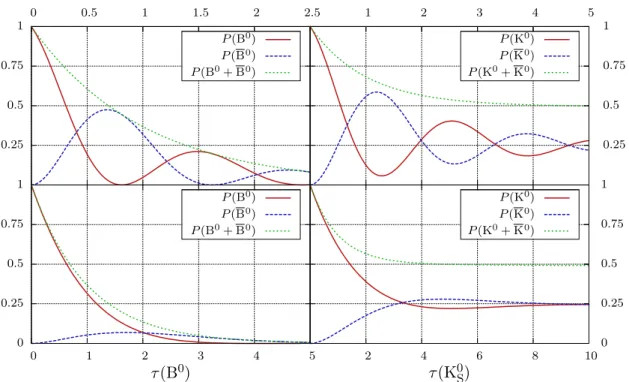
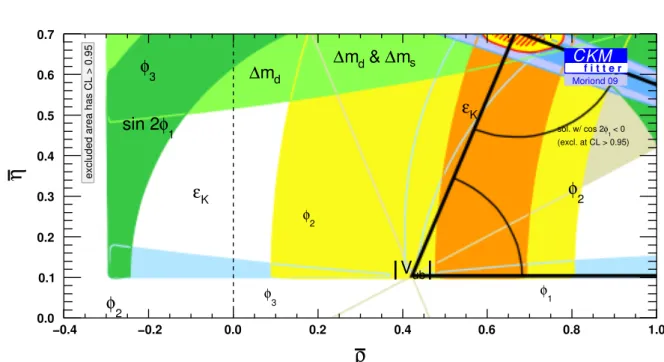
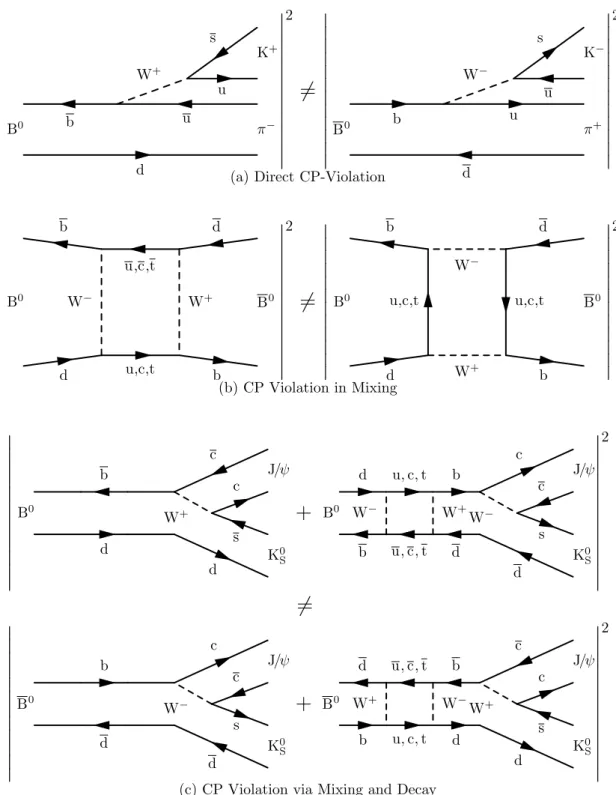
![Figure 2.9: Hadronic cross section for e + e − collisions as function of the e + e − center-of-mass energy in the region at and above the Υ(1S) [24]](https://thumb-eu.123doks.com/thumbv2/1library_info/4013930.1541282/28.892.160.674.191.527/figure-hadronic-section-collisions-function-center-energy-region.webp)

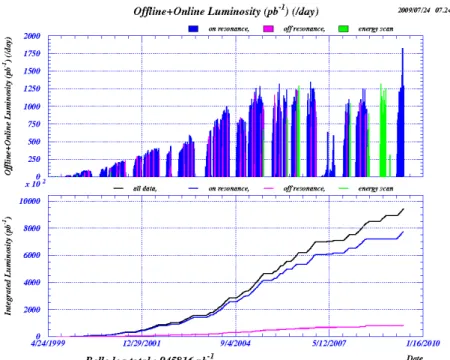
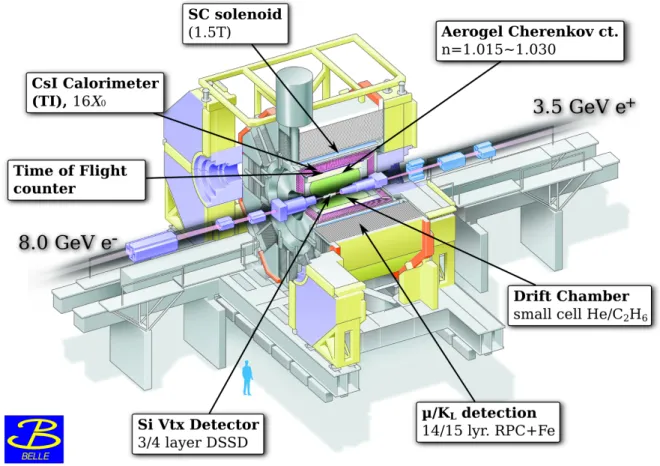

![Figure 3.6: Impact parameters of the SVD2 compared to the SVD1 [28]](https://thumb-eu.123doks.com/thumbv2/1library_info/4013930.1541282/36.892.131.718.235.538/figure-impact-parameters-svd-compared-svd.webp)